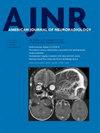淀粉样蛋白 PET 成像中 PET/MR 衰减校正的准确性和纵向一致性,以及软件和硬件的升级。
IF 3.7
3区 医学
Q2 CLINICAL NEUROLOGY
引用次数: 0
摘要
背景和目的正电子发射计算机断层显像(PET)/磁共振成像(MRI)整合技术可同时获取正电子发射计算机断层显像生物标记物以及结构和功能磁共振成像,用于研究阿尔茨海默病(AD)。衰减校正(AC)对正电子发射计算机断层显像(PET)的量化至关重要,可使用基于标准 Dixon 图像的深度学习方法 DL-Dixon 进行。纵向淀粉样蛋白 PET 成像可提供有关 AD 疾病进展或治疗反应的重要信息,通常需要数年时间才能获得。在长达数年的研究期间,硬件和软件经常会升级,从而导致数据的变化。本研究旨在统一 PET/MR DL-Dixon AC amid 软件和头线圈更新,并评估其准确性和纵向一致性。材料和方法从 329 名参与者中获得了三模态 PET/MR 和 CT 图像,其中 38 人在大约三年内接受了两次三模态扫描。采用迁移学习对两种扫描仪软件版本(VB20P 和 VE11P)和两种头部线圈(16 通道和 32 通道线圈)的图像进行 DL-Dixon 模型微调。对 DL-Dixon AC 的准确性和纵向一致性进行了评估。结果无论扫描仪软件版本和头部线圈如何,DL-Dixon 方法在所有数据中都表现出很高的准确性。在所有参与者中,95.6%以上的大脑体素显示 PET 相对绝对误差小于 10%。PET 平均相对绝对误差的中位数[四分位间范围]为 1.10% [0.93%, 1.26%],皮质汇总区为 1.24% [1.03%, 1.54%],0.99% [0.86%, 1.13%],1.04% [0.83%, 1.对 VB20P-16-channel-coil, VE11P-16-channel-coil 和 VE11P-32-channel-coil 数据使用 DL-Dixon 模型,小脑分别为 1.04% [0.83%, 1.36%]、1.08% [0.84%, 1.34%]、1.05% [0.72%, 1.32%]。皮质区域 PET SUVR 的受试者内变异系数和类内相关系数在 DL-Dixon 和 CT AC 之间具有可比性。结论DL-Dixon在两个软件版本和头线圈上都表现出了极好的准确性和纵向一致性,证明了它在AD的纵向PET/MR神经影像研究中的稳健性。缩略语AC=衰减校正;AD=阿尔茨海默病;HU=Hounsfield单位;ICC=类内相关系数;MAE=平均绝对误差;MRAE=平均相对绝对误差;pCT=伪CT;PiB=匹兹堡化合物B;SD=标准差;SUVR=标准化摄取值比;wCV=受试者内变异系数。本文章由计算机程序翻译,如有差异,请以英文原文为准。
Accuracy and longitudinal consistency of PET/MR attenuation correction in amyloid PET imaging amid software and hardware upgrades.
BACKGROUND AND PURPOSE
Integrated PET/MR allows the simultaneous acquisition of PET biomarkers and structural and functional MRI to study Alzheimer disease (AD). Attenuation correction (AC), crucial for PET quantification, can be performed using a deep learning approach, DL-Dixon, based on standard Dixon images. Longitudinal amyloid PET imaging, which provides important information about disease progression or treatment responses in AD, is usually acquired over several years. Hardware and software upgrades often occur during a multiple-year study period, resulting in data variability. This study aims to harmonize PET/MR DL-Dixon AC amid software and head coil updates and evaluate its accuracy and longitudinal consistency.
MATERIALS AND METHODS
Tri-modality PET/MR and CT images were obtained from 329 participants, with a subset of 38 undergoing tri-modality scans twice within approximately three years. Transfer learning was employed to fine-tune DL-Dixon models on images from two scanner software versions (VB20P and VE11P) and two head coils (16-channel and 32-channel coils). The accuracy and longitudinal consistency of the DL-Dixon AC were evaluated. Power analyses were performed to estimate the sample size needed to detect various levels of longitudinal changes in the PET standardized uptake value ratio (SUVR).
RESULTS
The DL-Dixon method demonstrated high accuracy across all data, irrespective of scanner software versions and head coils. More than 95.6% of brain voxels showed less than 10% PET relative absolute error in all participants. The median [interquartile range] PET mean relative absolute error was 1.10% [0.93%, 1.26%], 1.24% [1.03%, 1.54%], 0.99% [0.86%, 1.13%] in the cortical summary region, and 1.04% [0.83%, 1.36%], 1.08% [0.84%, 1.34%], 1.05% [0.72%, 1.32%] in cerebellum using the DL-Dixon models for the VB20P-16-channel-coil, VE11P-16-channel-coil and VE11P-32-channel-coil data, respectively. The within-subject coefficient of variation and intra-class correlation coefficient of PET SUVR in the cortical regions were comparable between the DL-Dixon and CT AC. Power analysis indicated that similar numbers of participants would be needed to detect the same level of PET changes using DL-Dixon and CT AC.
CONCLUSIONS
DL-Dixon exhibited excellent accuracy and longitudinal consistency across the two software versions and head coils, demonstrating its robustness for longitudinal PET/MR neuroimaging studies in AD.
ABBREVIATIONS
AC = attenuation correction; AD = Alzheimer disease; HU = Hounsfield unit; ICC = intraclass correlation coefficient; MAE = mean absolute error; MRAE = mean relative absolute error; pCT = pseudo-CT; PiB = Pittsburgh Compound B; SD = standard deviation; SUVR = standardized uptake value ratio; wCV = within-subject coefficient of variation.
求助全文
通过发布文献求助,成功后即可免费获取论文全文。
去求助
来源期刊
CiteScore
7.10
自引率
5.70%
发文量
506
审稿时长
2 months
期刊介绍:
The mission of AJNR is to further knowledge in all aspects of neuroimaging, head and neck imaging, and spine imaging for neuroradiologists, radiologists, trainees, scientists, and associated professionals through print and/or electronic publication of quality peer-reviewed articles that lead to the highest standards in patient care, research, and education and to promote discussion of these and other issues through its electronic activities.

 求助内容:
求助内容: 应助结果提醒方式:
应助结果提醒方式:


